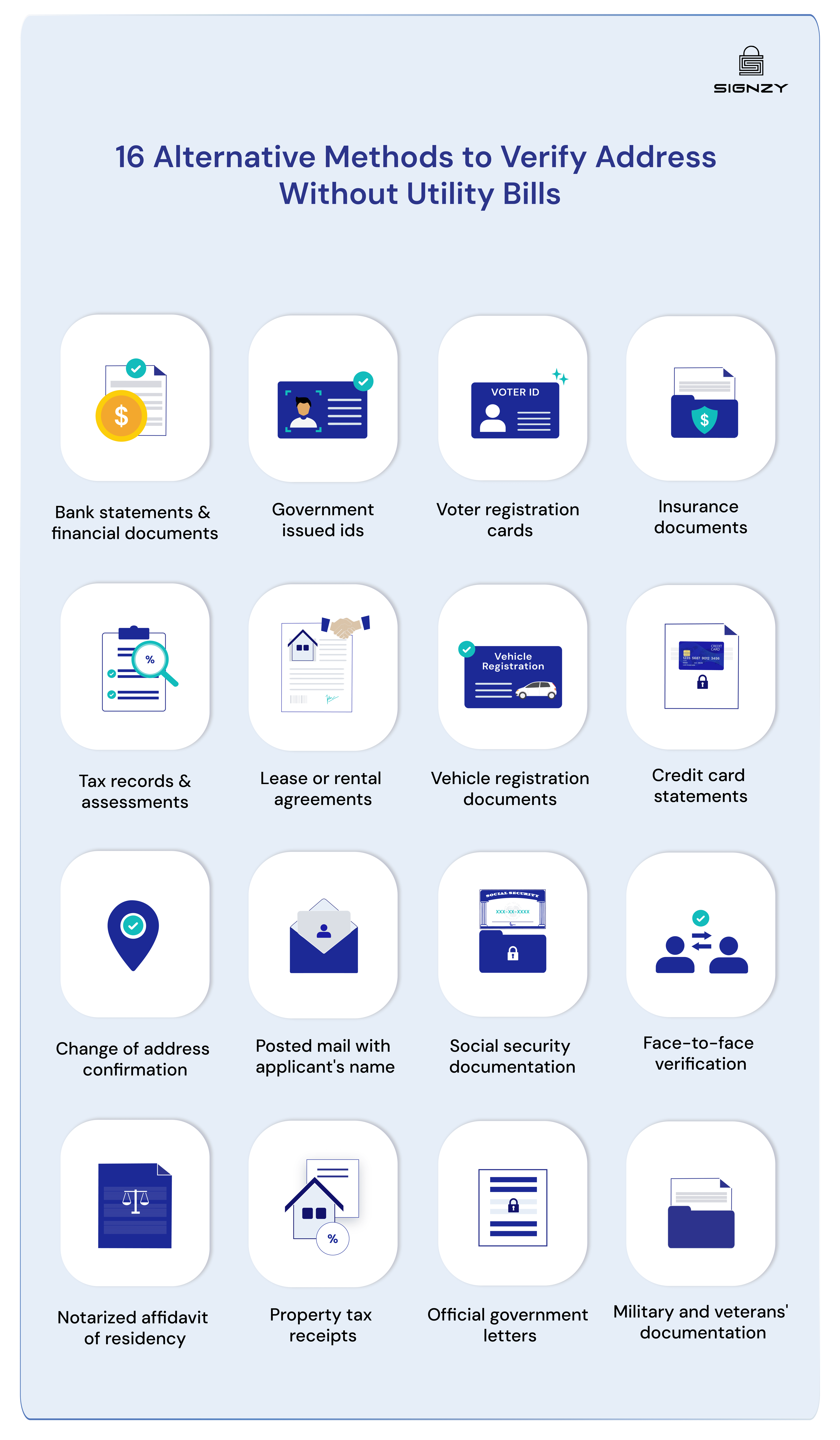16 Ways to Verify Address Without Utility Bills [2025 Guide]
- Current data shows that 17% of the population in America change addresses each year, showing the importance of having different verification options.
- Statistics indicate one in six American families moves annually, requiring reliable methods to confirm new addresses.
- Many residents cannot provide utility bills for verification, including students, recent movers, and those sharing housing, making alternative documentation necessary.
Not everyone can pull out a utility bill when you ask for one. Some of your customers live with family. Others have everything bundled into their rent. And let’s be honest – some just don’t keep track of these things anymore.
Meanwhile, your business still needs to verify addresses – regulators expect it.
But sticking to old-school verification methods means you’re probably turning away good customers or slowing down their onboarding.
ALL because they can’t produce that one specific document you’re asking for.
And guess what?
Not one, not two, not even ten – there are 16 possible alternative methods! (you read that right)
Let’s not drag on further – you want solutions, this guide details them – and it starts here. (nuts-and-bolts first).
Related Solutions
Why verify the address in the first place?
Because address verification helps prevent fraud and meets regulatory requirements for customer identification. When businesses fail to verify addresses properly, they’re basically leaving their front door open to identity theft and financial crime.
A mismatch between a claimed address and reality can be a sign of potential fraud. That’s exactly why regulators take this so seriously, particularly in financial services.
And while some might see it as a hassle, proper address verification actually supports several critical business functions:
- It ensures sensitive documents and communications reach the right person
- It helps maintain accurate customer databases for service delivery
- It protects against costly chargebacks and fraudulent accounts
- It builds customer trust through demonstrated security measures
Of course, there’s also the compliance angle – KYC (Know Your Customer) and AML (Anti-Money Laundering) regulations – let’s keep it for later and directly jump into alternative methods you can use to verify addresses without utility bills.
💡 Related Blog:
16 Alternative Methods To Verify Address Without Utility Bills
1. Bank Statements and Financial Documents
Monthly bank statements are often the first choice when utility bills aren’t available – and for good reason. Look for statements from the past three months, as older ones might not meet verification standards.
If your customer provides electronic statements, that’s perfectly fine too. What really matters is that they show the complete legal name, current residential address, and the issuing bank’s information clearly. And remember, while account balance details might be visible, they’re not relevant for address verification.
2. Government-Issued IDs
Here’s something many verification teams overlook: not all government IDs serve the same purpose. A driver’s license or state ID typically shows the most current address information, as people tend to update these when they move.
But here’s the catch – some regulations actually prevent using the same ID document for both identity and address verification. So it’s worth checking your local requirements first.
3. Voter Registration Cards
Voter registration cards often work better than you might expect. They’re government-issued and go through a verification process before being issued. Just keep in mind that they follow election cycles, so there might be a lag in address updates. Still, if the card shows the current address, it’s as good as any other government document for verification purposes.
4. Insurance Documents
Insurance documents offer reliable address verification because insurance companies maintain strict standards for customer information. Whether it’s home, auto, or health insurance, these documents work well as long as they’re current. Watch for current policy statements, insurance cards, or official correspondence.
Something worth noting: while digital copies are usually acceptable, they need to display all the key elements – policyholder name, current address, policy number, and insurance company details.
5. Tax Records and Assessments
Tax documents come directly from government agencies, which makes them highly reliable. They could be annual tax returns, property tax statements, or official tax correspondence. Also, while these documents are extremely reliable, they are typically updated annually. So if someone’s moved recently, they might need additional current documentation to support their new address.
6. Lease or Rental Agreements
These documents work exceptionally well when they’re properly executed. Look for complete lease agreements that show tenant names, property addresses, lease term dates, and all required signatures.
Even month-to-month agreements work well, but they should be current. But note – the document should clearly connect the person to the address through a legally binding agreement.
7. Vehicle Registration Documents
Vehicle registrations are particularly useful because people typically keep them updated to stay legal on the road. These documents come from DMV or equivalent agencies, making them quite reliable.
When reviewing vehicle registrations, check that the name and address match other provided documents. Sometimes you’ll see business addresses listed – in these cases, request additional documentation showing the residential address.
8. Credit Card Statements
Much like bank statements, credit card statements can also work as a solid address proof. They should be from the past three months and clearly show the cardholder’s name and current billing address. Many credit card companies provide electronic statements now – these are perfectly acceptable as long as they contain all the necessary information and come directly from the credit card issuer.
9. Change of Address Confirmation
USPS change of address confirmations works particularly well for recent moves. They’re valid for 30-90 days after the confirmation date, making them ideal for temporary verification. The key advantage? They show both the old and new addresses, creating a clear trail. Just remember to verify when the change took effect, as this impacts the document’s validity period.
10. Posted Mail with Applicant’s Name
Official mail can serve as address verification when it comes from recognized senders like government agencies or financial institutions. The mail should be from the past three months and show clear postmarks. Something important to note: personal correspondence or marketing materials typically don’t qualify – the focus is on official, traceable mail.
11. Social Security Documentation
Official Social Security Administration documents work well because they’re government-issued and regularly updated. Whether it’s benefit statements or Medicare correspondence, these documents typically meet verification requirements. Just ensure they’re recent and show the current physical address rather than a P.O. box.
12. Face-to-Face Verification
While this method might seem old-fashioned in our digital age, it’s actually quite effective for certain businesses. It involves customers presenting their identification documents in person, allowing for immediate verification. Banks and financial institutions often prefer this method for opening accounts.
13. Notarized Affidavit of Residency
Sometimes, it is used as a backup option when standard documents aren’t available. A notarized affidavit includes a sworn statement about the person’s residence, verified by a licensed notary public. But keep in mind that many organizations consider this a supporting document rather than standalone proof. It often works best when combined with other forms of address verification.
14. Property Tax Receipts
These documents work particularly well for homeowners. Property tax receipts combine official status with direct property ownership, making them quite reliable for address verification. When reviewing these documents, check that they’re current and show both the owner’s name and property address clearly. They’re especially useful because local tax authorities maintain accurate records for billing purposes.
15. Official Government Letters
Letters from government agencies provide strong address verification when they’re recent. These might come from tax authorities, social services, or other official departments. The key requirements? They should be on official letterhead, dated within the last three months, and show both the recipient’s name and physical address.
Many government departments now send official digital correspondence – these are just as valid as traditional letters when they contain the right information.
16. Military and Veterans’ Documentation
While not in our original list, military documentation deserves mention. Active duty military personnel and veterans often have unique living situations. Military orders, veterans’ benefits letters, and military ID cards with address information all serve as valid proof of address. These documents work well because they’re government-issued and regularly updated through official channels.

What To Not Accept as Address Proof?
Address verification requires reliable, official documentation. But not every document with an address on it meets proper verification standards.
Many documents that seem legitimate at first glance actually don’t provide the level of verification needed for regulatory compliance. This matters because proper address verification helps prevent fraud and ensures you’re meeting your KYC obligations.
Here’s what you should not accept as proof of address:
- Personal letters or statements from family, friends, or employers
- Handwritten or informal rental agreements
- Digital bills or screenshots without official letterhead
- Documents older than three months
- Social media profiles or online accounts
- Package delivery labels or shipping receipts
- Business cards or company letterheads
- E-commerce order confirmations
- Hotel bills or temporary accommodation receipts
- Self-printed documents, even with correct information
- Personal email correspondence
- Mobile phone screenshots of bills or statements
- Gym membership cards
- Library cards
- Magazine or newsletter subscriptions
When verifying addresses, always stick to official documents from recognized institutions. If a document seems questionable, it’s better to request additional proof than risk non-compliance.
Rules and Regulations around Address Verification
Financial institutions and many other businesses must follow specific regulations to verify customer addresses as part of their compliance obligations.
These regulations aim to prevent financial crime, identity theft, and money laundering while protecting both businesses and customers. Different industries and regions might have varying requirements, but most share common foundations in KYC and AML protocols.
- Bank Secrecy Act (BSA): Requires financial institutions to verify customer identity and address as part of their customer due diligence program. Regular updates and monitoring of customer information are mandatory.
- Customer Due Diligence Rule (CDD): Mandates that financial institutions must identify and verify the identity of customers, including their addresses, when opening new accounts.
- FINRA Rule 2090 (Know Your Customer): Requires member firms to verify customer information, including addresses, to ensure proper account handling and risk assessment.
- Anti-Money Laundering (AML) Directives: Specify that businesses must maintain accurate customer address information and verify any changes to prevent financial crimes.
In practice, these regulations mean businesses need documented processes for address verification, regular updates of customer information, and secure storage of verification records.
Verifying Addresses at Scale Using Signzy
When a business processes ten address verifications daily, a team member can carefully review each document. But what happens when that number jumps to 1,000? Or 10,000? Manual verification quickly becomes unsustainable, creating bottlenecks that frustrate customers and strain resources.
The real challenge isn’t just about handling volume – it’s about maintaining consistency and accuracy while managing costs.
This is where smart verification systems make a difference. Modern solutions like Signzy combine advanced document processing with automated compliance checks, helping businesses handle high-volume verifications efficiently. The result? Faster customer onboarding, reduced operational costs, and consistent compliance standards across all verification tasks. Explore more.
FAQ
What if my customer’s name on the proof of address is slightly different?
Are digital statements as valid as paper ones?
Do all verification methods work for international customers?
What if a customer has absolutely no traditional proof of address?

Roshan Kumar
Roshan leads product strategy for Identity and Fraud Verification at Signzy Technologies, where he oversees the development of secure, scalable ID Verification, Automated CKYC, and AI-powered Video KYC solutions for regulated banks and fintechs. With over five years of hands-on experience in KYC and API banking and a strong engineering background, he focuses on building platforms that ensure seamless and compliant onboarding across the BFSI sector. His expertise spans designing and implementing solutions that address evolving regulatory requirements and industry challenges.

![16 Ways to Verify Address Without Utility Bills [2025 Guide]](https://cdn.sanity.io/images/blrzl70g/production/3dea0d94a1282989154c983a3e4d1b53aa07f539-2560x600.webp)




